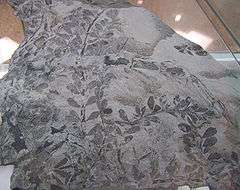Sphenophyllales
| Sphenophyllales Temporal range: Devonian–Triassic | |
|---|---|
 | |
| Fossil leaves and branches of the species Sphenophyllum miravallis, Upper Carboniferous. Collection of the Universiteit Utrecht. | |
| Scientific classification | |
| Kingdom: | Plantae |
| Division: | Pteridophyta |
| Class: | Equisetopsida C. Agardh |
| Order: | †Sphenophyllales Seward, 1898 |
| Genera | |
|
†Sphenophyllum | |
| Wikimedia Commons has media related to Sphenophyllales. |
Sphenophyllales is an extinct order of articulate land plants and a sister group to the present-day Equisetales (horsetails). They are fossils dating from the Devonian to the Triassic. They were common during the Late Pennsylvanian to Early Permian, with most of the fossils coming from the Carboniferous period.[1][2]
Description
Sphenophyllales are small, slender branching plants, usually growing to a height of less than 1 m (3.3 ft) tall. The long stems range from 0.5 cm (0.20 in) to 1.2 cm (0.47 in) in diameter. The stems are jointed and ribbed with weak habits, making it probable that these plants were vine or shrub-like when alive, and formed a portion of the understory in Carboniferous forests. The stem anatomy is protostelic (root-like), containing a solid primary xylem core with secondary xylem tissue present in some species. The leaves, which can be several centimeters long, are borne on each node in whorls (called verticels) and are wedge-shaped, fan-shaped, linear, or forked. Reproductive parts are either long terminal cones (consisting of two lobes, a sterile lower lobe and the fertile upper lobe bearing the sporangia) or loose strobili. All sphenophylls are homosporous, with monolete or trilete spores[3][4][5]
Taxonomy
Sphenophyllales was first described by the British botanist and geologist Albert Charles Seward in 1898.[6] The name comes from the Greek words σφήν ("wedge") and φύλλον ("leaf").
Sphenophyllalean taxonomy is often derived from isolated fossilized parts of plants and classification may be based on the morphology and anatomy of sterile plant parts (like leaves) or fructifications (mainly the fossilized cones and the stratigraphically-important spores found near them). This results in species that may actually by synonymous.[5][6] Sphenophyllales is typified by the genus Sphenophyllum.
Phylogeny
The probable relationships within Equisetopsida are shown in the cladogram below. The possible position of Ibyka has been added.[7]
| |
| |||||||||||||||||||||||||||||||||
| |
References
- ↑ Sybil P. Parker, ed. (1986). Grolier Concise Encyclopedia of Science and Technology. Volume V. Danbury, Connecticut: Grolier International. p. 1637. ISBN 0-7172-8525-1.
- ↑ "Introduction to Sphenophyllales". University of California Museum of Paleontology, http://www.ucmp.berkeley.edu/. Retrieved 27 January 2011. External link in
|publisher=(help) - ↑ "Sphenophyllales". Access Science, http://www.accessscience.com. Retrieved 27 January 2011. External link in
|publisher=(help) - ↑ Seward, A. C. (2006). Darwin and Modern Science. Middlesex, England: The Echo Library, www.echo-library.com. ISBN 1-4068-0480-0.
- 1 2 Thomas N. Taylor; Edith L. Taylor; Michael Krings (2009). Paleobotany:the biology and evolution of fossil plants. Academic Press, New York. ISBN 978-0-12-373972-8.
- 1 2 Milan Libertín; Jiří Bek & Jana Drábková (2008). "Two New Carboniferous Fertile Sphenophylls and their Spores from the Czech Republic". Acta Palaeontologica Polonica. Institute of Paleobiology, Polish Academy of Sciences; BioOne, www.bioone.org. 53 (4): 723–732. doi:10.4202/app.2008.0414.
- ↑ "Introduction to the Sphenophyta". University of California Museum of Paleontology. Retrieved 31 July 2011.